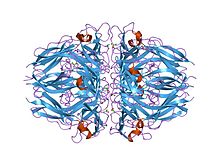Collagen IV is a type of collagen found primarily in the basal lamina. The collagen IV C4 domain at the C-terminus is not removed in post-translational processing, and the fibers link head-to-head, rather than in parallel. Also, collagen IV lacks the regular glycine in every third residue necessary for the tight, collagen helix. This makes the overall arrangement more sloppy with kinks. These two features cause the collagen to form in a sheet, the form of the basal lamina. Collagen IV is the more common usage, as opposed to the older terminology of "type-IV collagen". Collagen IV exists in all metazoan phyla, to whom they served as an evolutionary stepping stone to multicellularity.

Collagen XVII, previously called BP180, is a transmembrane protein which plays a critical role in maintaining the linkage between the intracellular and the extracellular structural elements involved in epidermal adhesion, identified by Diaz and colleagues in 1990.

Collagen alpha-1(V) chain is a protein that in humans is encoded by the COL5A1 gene.
Interstitial collagenase, also known as fibroblast collagenase, and matrix metalloproteinase-1(MMP-1) is an enzyme that in humans is encoded by the MMP1 gene. The gene is part of a cluster of MMP genes which localize to chromosome 11q22.3. MMP-1 was the first vertebrate collagenase both purified to homogeneity as a protein, and cloned as a cDNA. MMP-1 has an estimated molecular mass of 54 kDa.

Collagen alpha-1(VII) chain is a protein that in humans is encoded by the COL7A1 gene. It is composed of a triple helical, collagenous domain flanked by two non-collagenous domains, and functions as an anchoring fibril between the dermal-epidermal junction in the basement membrane. Mutations in COL7A1 cause all types of dystrophic epidermolysis bullosa, and the exact mutations vary based on the specific type or subtype. It has been shown that interactions between the NC-1 domain of collagen VII and several other proteins, including laminin-5 and collagen IV, contribute greatly to the overall stability of the basement membrane.

Collagen alpha-3(IV) chain is a protein that in humans is encoded by the COL4A3 gene.

Collagen alpha-1(IV) chain (COL4A1) is a protein that in humans is encoded by the COL4A1 gene on chromosome 13. It is ubiquitously expressed in many tissues and cell types. COL4A1 is a subunit of the type IV collagen and plays a role in angiogenesis. Mutations in the gene have been linked to diseases of the brain, muscle, kidney, eye, and cardiovascular system. The COL4A1 gene also contains one of 27 SNPs associated with increased risk of coronary artery disease.

Collagen alpha-2(IV) chain is a protein that in humans is encoded by the COL4A2 gene.

Laminin subunit gamma-2 is a protein that in humans is encoded by the LAMC2 gene.

Laminin subunit alpha-1 is a protein that in humans is encoded by the LAMA1 gene.

Collagen alpha-1(X) chain is a protein that in humans is a member of the collagen family encoded by the COL10A1 gene.

Collagen alpha-2(VI) chain is a protein that in humans is encoded by the COL6A2 gene.

Collagen alpha-1(IX) chain is a protein that in humans is encoded by the COL9A1 gene.

Fibromodulin is a protein that in humans is encoded by the FMOD gene.

Collagen alpha-1(XIII) chain is a protein that in humans is encoded by the COL13A1 gene.

Collagen alpha-1(XIX) chain is a protein that in humans is encoded by the COL19A1 gene.

Collagen alpha-3(V) chain is a protein that in humans is encoded by the COL5A3 gene.

Collagen alpha-1(XVI) chain is a protein that in humans is encoded by the COL16A1 gene.

Collagen alpha-1(XXV) chain is a protein that in humans is encoded by the COL25A1 gene.

Collagen α-1 (XXIII) chain is a protein encoded by COL23A1 gene, which is located on chromosome 5q35 in humans, and on chromosome 11B1+2 in mice. The location of this gene was discovered by genomic sequence analysis.















